VisionTek CryoVenom R9 295X2: Two GPUs In One Slot
VisionTek recently introduced its CryoVenom R9 295X2, a dual-GPU graphics card that squeezes into a single PCIe expansion slot thanks to a thin and effective water block with impressive thermal performance. But is the board worth its price premium?

VisionTek CryoVenom R9 295X2 Graphics Card Review
[Oct 13/2014 addendum: Visiontek has lowered pricing across its liquid-cooled graphics card line in response to feedback from this article, and the CryoVenom R9 295X2 kits have dropped a whopping $300. We have reflected this change in our writeup below. You can check the Visiontek website for specific details.]
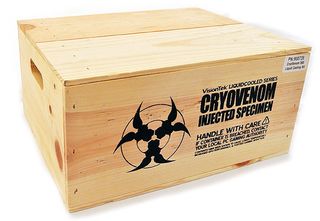
Liquid cooling is one of the most practical thermal management solutions that a PC enthusiast can install, and it enables some interesting hardware configurations. For example, AMD realized that air cooling wasn't potent enough to handle its power-hungry Radeon R9 295X2, so the company chose to equip the board with an Asetek-supplied closed-loop liquid cooler. This enables a dual-slot solution that keeps GPU temperatures and noise relatively low. As a result, the Radeon R9 295X2 isn't difficult to live with, unlike some of its dual-GPU air-cooled predecessors.
Just because AMD's reference cooler is decent, however, doesn't mean that it's the best you can get. Open-loop implementations facilitate flexibility when it comes to installation, expansion, and performance. Of course, removing the factory cooler to replace it with a third-party solution voids your warranty, so there's a compromise to make.
If you're not a fan of give and take, VisionTek has a solution: the CryoVenom Radeon R9 295X2, a single-slot version of AMD's powerful flagship, outfitted with an open-loop cooling block and covered by a one-year factory warranty.
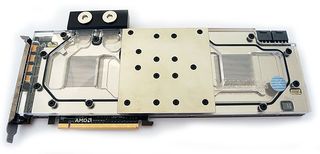
Again, this is a single-slot graphics card, unlike the dual-slot reference Radeon R9 295X2. That provides more space if you're planning a dual-card CrossFire configuration, and two CryoVenom cards could theoretically share the same loop. On the other hand, two reference 295X2s require the installation of two separate radiators and the attached generic-length hoses. In some PC enclosures, it's just not an option.
Not that I'm advocating the use of two Radeon R9 295X2 cards in CrossFire. But an open-loop liquid cooling system does provide more flexibility. Once you have the system in place, it's relatively easy to expand by linking in a second graphics card, a CPU or a chipset block. It's a highly customizable system.
With this flexibility in mind, VisionTek offers a number of different purchase options for its CryoVenom cards. If you already have your own open-loop cooler, you can purchase the card alone for $1450. If you need everything to get you started (including a reservoir, pump, radiator, fans and hardware), you can pick up the Radeon R9 295X2 plus 240 liquid cooling kit (240 indicates a radiator that fits two 120mm fans) for $1700. If you want something even more powerful, an extra $50 gets you the 360 liquid cooling kit with a radiator large enough to accommodate three 120mm fans.
Stay on the Cutting Edge
Join the experts who read Tom's Hardware for the inside track on enthusiast PC tech news — and have for over 25 years. We'll send breaking news and in-depth reviews of CPUs, GPUs, AI, maker hardware and more straight to your inbox.

We wanted to see what VisionTek's highest-performance option can accomplish, so we tried its CryoVenom R9 295X2 + 360 liquid cooling kit. As you can see in the picture above, this includes all of the equipment you need to get up and running: the card, the pump with integrated reservoir, cooling fans, about six feet of tubing, coolant and hardware. There's even a t-shirt included in the serious-looking pine box.

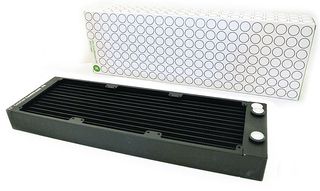
Of course, that box isn't big enough to hold everything, so the triple-120mm radiator comes in a second package. Note the EKWB logo on the box. VisionTek is partnering with this highly regarded company to supply the CryoVenom's liquid-cooling components. The radiator is actually EKWB's CoolStream PE 360 Triple, about 40mm thick with copper fins, 90% copper tubing, brass chambers and an aluminum housing. Each of the three fans is rated at 58.8CFM and spins at 1600RPM.

The pump and reservoir are combined in a single, attractive unit that sits in a 5.25" drive bay, allowing you to monitor the liquid level. This appears to be an EK-SBAY with an EK-DCC 3.2 PWM pump, specially branded for VisionTek's CryoVenom series. The maximum head pressure is rated at 5.2m. It's backlit, so colored coolant adds some extra bling, too.
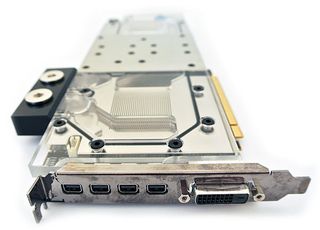

That's a reference Radeon R9 295X2 PCB under the cooling block, with AMD's standard DVI connector and four mini-DisplayPort outputs. But while the reference liquid cooler only draws heat from the Hawaii GPUs, EKWB's cooling block is applied to the GPUs, memory and voltage regulator modules (VRMs). Keep in mind that we have previously shown that those VRMs can reach over 105 degrees Celsius under load, so the CryoVenom's ability to cool them represents a substantial advantage over the reference card.
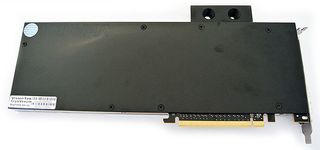
The CryoVenom R9 295X2 has a sturdy metal backplate to maintain structural integrity. Even without coolant, VisionTek's card weighs a substantial 1.564 kilograms.
Current page: VisionTek CryoVenom R9 295X2 Graphics Card Review
Next Page Installing The CryoVenom R9 295X2-
youcanDUit YOU GOT ZOMBIE BLOOD ON YOUR LEG. YOU'RE INFECTED!Reply
http://www.dailymotion.com/video/x87h9y_28-days-later-28-days-later-blood-i_shortfilms -
Nuckles_56 I'm impressed with how cool that card runs, and damn is it sexy as well- apart from the price...Reply -
AndrewJacksonZA I would *NOT* mind two of these in my computer!!! However, how much are 4x 980s? :-(Reply
Although the inner geek in me STILL wants two of these cards! :-) -
Nuckles_56 Reply14367051 said:I would *NOT* mind two of these in my computer!!! However, how much are 4x 980s? :-(
Although the inner geek in me STILL wants two of these cards! :-)
4 gtx 980's will be less than two of these -
ta152h With the 390 coming out in a few months, and being moved to 20nm, this is heading towards severe obsolescence in the near future. The magnitude of the change is pretty large, since it's the first shrink in years, and is purported to be an extensive redesign as well.Reply
It's hard to justify tossing away $1000 away with this in mind. $2000 is even more difficult.
Yes, new technology is always around the corner, but these days it's often relatively minor, compared to what the 390 will be. We don't get shrinks that often anymore. I'd wait for it, unless you have enough money you can get both with no difficulty. Then, why not? -
B4vB5 This card is pretty irrelevant for normal people unless they want it out of spite.Reply
For computation farms and HPC, it's kinda interesting as you can now stuff 6-7 of these cards on the same motherboard and use 14 GPU's for OpenCL programming before you have to pay the overhead of another node in the farm(mb, cpu,ram,psu,cooling components).
The question is though if the high price tag and the high power consumption will pay off this cost saving in the long run, or 7x 290x is the better choice?
Nvidia is irrelevant for HPC/compute farms or at least use to be as they are much slower than AMDs cards.
If physical space matters and cost not so much, this could be a grand choice for now, simply for being able to stuff 14 GPU on one motherboard. SLI/Xfire dont matter and PCI 3.0 1x is usually enough although WS mb's from Asus with PLX onboard can handle PCI 3.0 8x/16x(well 84 total lanes) for high interaction/communication capability, though this is usually not the case in my experience with HPC via gfx.
Of cause you could also pick 7x normal 295x2s with extenders to PCI-e ports but then space and adequate cooling becomes a major issue(compute farms are suppose to run the cards at 80-100% most of the time to justify their existance).
I can see a slim market for this card though. And maybe for 5K gaming for extremist rich people in 3-4x Xfire if that even works and doesn't just falter in actual gaming performance like Linus latest video on the subject showed with 3-4x SLI. -
WilliamChan4 What happened to Eyefinity 6? Some time ago, having 6 mini-displayports in a single slot was supposed to be "the way of the future". Surely, if people still have legacy hardware, a simple converter cable would be a much better option than less display bandwidth.Reply -
Haravikk $2000 for a graphics card that will probably still be lagging behind in a few years? No thanks! Hell, I'm not sure I'd even spend $2000 in total to make a strong gaming rig, this just seems like one of these things that is only suited to people who feel a crushing burden from having too much money in their bank account, as anyone with any sense can build an extremely good system with $600-700 worth of GPU(s), and even that's still a bit overkill.Reply
